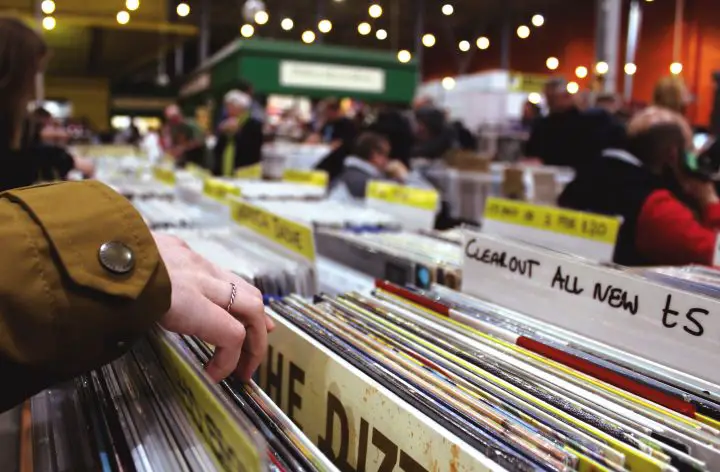Are you sick and tired of all the rhetoric? Do you want a straight answer to the question of how much your records are worth? Wouldn’t it be great if there was a vinyl record price guide to help you navigate the various factors that affect the price a record can command?
Then join us as we explore the various factors that determine the price of a record.

The Short Answer
It’s difficult to give a broad answer about how much your own vinyl record is worth. The worth of any vinyl record is based on a number of varying factors, many of which will be dealt with and explored in greater detail below.
There is, however, a certain metric that many record collectors tend to follow, whereby the rarity of a record and the popularity of the artist relate to one another and a number of ways.
Michael Jackson’s Thriller for example is a highly revered album but, because of its popularity, it is in no way rare and therefore worth little when put up for sale (this isn’t, of course, his only valuable record either). There are, on the other hand, certain Beatles records whether promotional or not that are worth far more because of their rarity in the face of popularity.
Age
Old records must be worth more than new ones, right? While age can have an effect on a vinyl record’s value, it’s surprisingly one of the least important factors.
Releases from earlier in the career of a famous artist may have more value than those from later in their careers, particularly if they didn’t become famous right away. A good example of this would be the recordings of Elvis Presley.
While his first five records for the Memphis-based Sun label sold reasonably well for their day, their sales figures were minuscule compared to those of his later releases on RCA. This, in turn, makes the lesser-selling Sun versions fairly valuable.
The Artist
The artist in question will be one of the bigger factors in determining the value of a record. While tens of thousands of artists have released records since the invention of the medium, not all of them interest the public in equal measure.
Some artists are simply more popular as well as more collectible than others. Artists in the rock, blues, jazz, classical, and soul categories, for example, tend to be more collectible than those in the easy listening, country, spoken word, or comedy categories, though this is by no means to deny their value to a whole league of others.
Some artists also tend to have a longtime following, while others are popular only while they are actively recording. With the former, such as Elvis Presley, Pink Floyd, blues singer Robert Johnson, or the Beatles, many of their records remain both valuable and highly collectible long after they stopped recording or even after their deaths.
Other artists, though, may have had records with high values only during the time they were recording, with prices in the collector market dropping considerably after they finished their careers or when they passed away. Strange!
Rarity
Records that sell well in their time are quite common and, thus, are going to be less valuable than records that sell poorly or are hard to find. A lot of albums sold in the 1970s and early 1980s sold millions of copies when new, and as such, it isn’t difficult to find copies in nice, playable condition.
That being the case, such records aren’t likely to sell for very much money in the collectors market, as already discussed above.
On the other hand, even records that sell well when new can become scarce in time, especially when one takes the condition of the record into account. Albums by Elvis Presley and the Beatles sold millions of copies when they were first released, but finding nice original copies of those records now can be difficult, as many have been thrown away or damaged through heavy play or abuse.
Sealed
Because the condition of a record is held to be important by collectors, the ideal example of a record to own, in the eyes of many collectors, would be one that has never been played at all. Because of this, collectors will often pay a huge premium for sealed, unopened examples of records they are seeking.
When record albums were first offered in the late 1940s, they were sold without any external wrapping on the cover. Customers in record stores could remove the records from the cover and many stores would even allow them to play the records to help them make a buying decision.
This led to problems with both theft and damage and by the early 1960s, a number of large retailers started sealing their albums in plastic bags. Eventually, this practice was picked up by the major record companies, who began protecting their covers with shrink wrap.
The difference in price can range from modest to quite significant, depending on the artist and title. A sealed copy of a relatively recent release may carry a small advantage over an opened copy, but older and/or more desirable titles may exhibit a substantially larger advantage. Sealed copies of older albums by the Beatles might sell for as much as ten times the price of an opened example, for instance.
Autographs
While autographed albums and singles aren’t particularly common (forgeries of them are, though), they usually do command a premium over regular copies of the record that are not signed for this reason.
Autographed records that are personalized tend to sell for less money than those that simply have the artist’s signature on them. When it comes to musical groups and autographs, albums that are autographed by the entire group will sell for substantially higher prices than those with the signatures of some, but not all, members. Hey, that’s just the way the cookie crumbles.
Autographed records with provenance, such as a photograph of the artist signing the record, tend to bring the highest prices of all for obvious reasons.
Promotion
Promotional copies of a record are often identifiable in some way and thus often have a special label that indicates that the particular record was made for promotional or radio use. While the labels on most records are colored, many promotional issues have white labels.
Promotional copies of records are usually pressed before retail copies to ensure that they reach radio stations prior to the commercial release of the record. They are also pressed in relatively small quantities compared to stock copies of the same records. While an album may sell in the millions, there may be only a few hundred promotional copies made of that same record, hence why they are often collector’s items.
Sometimes, promotional copies of a particular record may be different from the stock counterpart. The promotional copies of the Beatles’ single “Penny Lane” had a different ending than the version of the song on the stock copies of the single, making these rare copies quite valuable in comparison to the million-selling stock counterpart.
On other occasions, a record may be issued only as a promotional item. Such albums may be live recordings, made for radio broadcasts or compilation albums intended to stimulate airplay.
These “promo-only” releases are still usually sought after by collectors, though the interest in them will be directly related to the interest in the artist. A promo-only Rolling Stones record, for example, will attract far more interest from collectors than one by Andy Williams.
Little Label vs Big Label
Larger record labels have national distribution and multiple pressing plants, and popular records might be pressed in the millions. Smaller labels might press only a few hundred or several thousand copies of a particular record.
There are examples of records being initially released on small labels and then later released on larger labels when the small record company negotiated a distribution deal with the larger label in order to sell more records, many examples of which exist in the popular cultural pantheon.
It shouldn’t be too hard to see how factors like this can affect the price of a record in the long run.
Variations
A given album or single might have been released with several different labels on the disc itself, even among releases by the same record company at the same time.
Record companies often change the appearance of the labels used on their records. While it has happened less often in recent decades, changes in label art and appearance were quite common among the major labels during the 1960s and 1970s as they constantly fluxed to meet new appeal.
Records by the Beatles, for instance, were released in the US by Capitol Records on a black label with a rainbow-colored perimeter, a green label, a red label, a custom Apple label, an orange label, a purple label, and a new version of the original black label, all over a period of about 20 years.
Collectors tend to favor original pressings, so for a given title, the most desirable label variation would be whichever one was in use on the day the record was originally released for sale to the public. There are exceptions to this, however.
The red Capitol label mentioned above was commonly used in the early 1970s for a number of titles but was never intended to be used for records by the Beatles. A few copies of the band’s Revolver and Yesterday and Today albums were accidentally issued with that label, and despite not being “original” issues, they do sell for quite a lot of money on the collector’s market. Some types of record collectors are just fiends for anything uncommon.
Mono or Stereo or…
Until 1957, vinyl records were sold only in mono but between 1957 and 1968, records were usually sold in both mono and stereo, and between about 1972 and 1976, a few records were available in 4-channel quadraphonic sound.
During the time when records were sold in more than one format simultaneously, one of the formats was usually pressed in smaller quantities than the other. Mono records were more common than their stereo counterparts in the early 1960s, for instance, but were the harder variation to find by 1968. Quadraphonic pressings were always intended for a niche market, and never sold in large quantities, except in the few cases where all copies of a particular title were encoded in quadraphonic sound.
While the value of a mono record in relation to its stereo counterpart will depend on when the record was released, quadraphonic copies are almost always worth more money than the same album in stereo for obvious reasons.
Colored and Picture Discs
While most records are pressed from black vinyl, sometimes other colors are used. On rare occasions, a special process is used to create a picture disc, which bears a photograph or other graphics actually embedded in the record’s playing surface. With few exceptions, colored vinyl and picture disc pressings are almost always limited editions, and thus usually far harder to find than their black vinyl counterparts.
In the late 1970s, picture discs were often pressed as promotional items and became quite popular among collectors. Most of these were pressed in quantities of only a few hundred copies.
More often, colored vinyl and picture disc records are issued as limited edition pressings, created to spur interest among buyers. Most of these titles are also available on regular old black vinyl.
As with everything else on this list, there are occasional exceptions to the rule. Elvis Presley’s last album to be issued while he was alive was Moody Blue, which was pressed on blue vinyl when originally released. A couple of months later, RCA Records began to press the album on regular black vinyl as a cost-cutting move, which would have made the blue pressings rare and desirable.
Shortly after this decision was made, Elvis passed away for separate reasons, and the label made the decision to return to blue vinyl for that album, and all pressings for the next ten years or so were issued blue vinyl. In the case of Moody Blue, it’s the black vinyl pressings that are actually the rare ones. Who knew?
Picture Sleeves
While vinyl record albums usually include printed covers, most 45 RPM singles do not, as they were generally issued in plain paper sleeves. It was not uncommon, however, for singles to be issued in printed sleeves bearing the title of the song, the name of the artist, and perhaps a graphic or photograph.
These are known as picture sleeves, and most of the time, these picture sleeves were available only with the original issues of the records. While not intended as limited edition items per se, picture sleeves were designed to spur sales and were often discontinued once sales of the record began to pick up.
For various reasons, some picture sleeves are harder to find than others, and there are a number of records, some by famous artists, where certain picture sleeves are rare to the point where only a few copies are known to exist. Some picture sleeves, such as “Street Fighting Man” by the Rolling Stones – whose cover depicted an act of police brutality – were withdrawn prior to release, and thus can sell for more than $10,000.
Test Pressings and Acetates
While the majority of records are standard issues that were manufactured with the intention that they be sold in stores, some are pre-production versions that were made for in-house use at the record companies prior to making the stock pressings.
Acetates, or lacquers, as they are more properly known, are records that are individually cut on a lathe by a recording engineer. The recordings are cut on metal plates that are coated with soft lacquer. Acetates are the first step in the process of making a record, as they can be plated with metal and used to make stampers for the production of copies sold in stores.
They can also be played on a turntable and are often used to evaluate the sound of a song or an album prior to putting it into formal production. While acetates can be played as one would play any regular record, they don’t wear particularly well and will become quite noisy after only a few plays.
Test pressings are a bit more common than acetates, and are made to test stampers prior to mass-produced production runs. They are usually the first pressings made from a set of stampers and can be distinguished by their labels, which will differ from those used on stock pressings. Test pressings may have blank white labels or they may have special labels that indicate that they are test pressings. These custom labels usually have blank lines printed on them so that the people working with them can write the title and artist on the labels by hand.
As with acetates, test pressings are usually used for evaluation purposes by record company personnel, though they are occasionally sent out as promotional items. As they are rather unusual and limited in production to just a handful of copies, test pressings are highly regarded and sought out by collectors. Sometimes, test pressings may contain different versions of one or more songs from commercially released albums which can also add to their value.
Foreign Copies
Most record albums are designed by record companies in either the United States or Great Britain, and most releases from either country are nearly identical. Other countries, however, have been known to create dramatically different versions of records from their U.S. or UK counterparts because of the different socio-political resonances cover art and lyrical content might have there.
Sometimes, for example, foreign pressings may have different titles, or different covers from the more common versions from the U.S. or UK. On other occasions, record companies in other countries may choose to press albums on colored vinyl.
Many albums from Japan from the late 1950s through the early 1970s were pressed on dark red vinyl. Japanese pressings were also issued with a paper sash, or “obi,” that wrapped around the cover and provided information for the buyer in Japanese.
These pressings are highly regarded by collectors for both their unusual appearance and their sound quality, hence the increase in the vinyl records value.
Withdrawn Copies
Occasionally, record companies release an album or single, only to change their mind and withdraw it from general release. This can happen for a number of reasons, ranging from a corporate decision that may or may not have anything to do with the record itself, a decision by the artist to change the product after release, or even an announcement by prominent retailers that they will refuse to sell the record as released.
Regardless of the reason for withdrawing the record from circulation, such releases will naturally be scarce, hard to find, and in demand among collectors. More often than not, withdrawn releases will also command substantial prices on the collector market.
Counterfeits
While there are many factors that go into determining vinyl record value, perhaps none is more important than the need for the record to be an original pressing and not a counterfeit pressing created at a later date to resemble the original issue.
Counterfeit records first appeared on the market in the late 1960s or early 1970s and while the early attempts were rather obvious and fairly crude, technology has improved in recent years, making many counterfeit records difficult for the layperson to identify. The practice isn’t limited to rare or valuable titles, either, as a number of mass-produced titles were counterfeited in the late 1970s. These titles were sold by chain record stores alongside the legitimate record company issues.
If a record routinely sells for a lot of money, there is a good chance that the title in question has been counterfeited. Many albums by the Beatles, along with other popular artists such as the Yardbirds, Elvis Presley, and Pink Floyd, have been counterfeited.
Condition
While all of the factors listed above are important when it comes to evaluating a vinyl record’s value, perhaps none is as important as the condition of the record. Most mass-produced records sold over the past 60 years or so have been poorly cared for by their owners. They may have been played on low-quality equipment, stored outside of their covers, and handled by their playing surfaces, rather than their edges.
Collectors are interested in buying records in the best possible condition, and ideally, they’d like to own copies of all of their records in the same condition in which they were originally sold – mint and unplayed, with pristine covers.
How to Determine the Value of Your Own Records
Now you’ve seen which factors determine the value of a record, which make a valuable record and which don’t, let’s see if we can help you determine the worth of your own records.
1. Identify the Release
Most albums have been issued more than once, resulting in different release versions. To determine the value of your record, you must first identify it.
Start by looking for a Catalog Number on your record, which is often found on the album sleeve or pressed on the inner ring of the vinyl itself. Next, search for a barcode number. Lacking either of these options, make note of other details: label, track titles, etc.
2. Use an Online Record Store
Once you have your identifying info about the release version, you will need to find it on an online record store like Discogs. You can do this by typing in the Catalog Number, barcode number, or other details into the search bar. If the record has a barcode, you can also scan it with a vinyl app.
When in doubt, simply search for the album title, navigate to the Master Release page, and use the “Find Your Version” function to locate your specific release. Once you do, double-check your info to make sure it’s a match.
3. Assess the Value through the Sales History
Discogs provides the most recent sales history for every item sold in the Marketplace. Each record’s lowest, median, and highest sale price is automatically calculated and displayed on the release page based on the 30 most recent sales of that item.
Immediately available will be the lowest, median, and highest prices that the release has been sold for on Discogs. By clicking on the Last Sold date, you can view more sales history, including the average vinyl price and a chart to track trends over time.
Final Tones
So, there you have it! Hopefully, you are now feeling ready and able to get out there and sell your records accurately.
FAQs Vinyl Record Price Guide
How do I find out how much my vinyl records are worth?
To find out the worth of your vinyl records, the easiest route you can follow is to use a service like Discogs. This vast online music store also allows users to catalog and sell their records accurately with up-to-date information.
Is there an app to check vinyl prices?
The vast and oligarchical vinyl record store Discogs also has an app that is free and easy to use, offering accurate and up-to-date information by which to check current vinyl prices across the spectrum of sound.
What old records are worth money?
There is, however, a certain metric that many record collectors tend to follow, whereby the rarity of a record and the popularity of the artist relate to one another and a number of ways.
What are 45 records worth?
Many 45s trade for pennies and cents. But, and this is a big but, many 45s go for reasonable sums of money, anything from a few Dollars and Pounds to hundreds and thousands. Original 45s are highly collectible and should not be underestimated as a value store.
Are my vinyl records valuable?
The amount of money it is possible to make from your pre-owned vinyl will depend on the album, its condition, and whether the unique pressing has any significance – such as being a first pressing or limited edition run. The more rare a record – and the better its condition – the higher its sale value is likely to be.
Are vinyl records from the 40s worth anything?
Vinyl was never used as a substrate for 78 rpm recordings. Those were always made of shellac or acetate When vinyl came into use in the late 40s, it was often colored to help sell it or clear (best for purity), but people resisted the change in color. They were used to records being black, so manufacturers were obliged to adulterate the vinyl with carbon black, or people wouldn’t buy the records!





